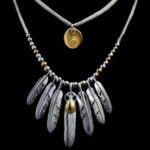Titanium is a relative newcomer to the jewelry industry, but its rich color palette and visual impact have quickly made it a favorite among designers and artists. This new material has inspired many outstanding titanium jewelry pieces, allowing the metal to shine brilliantly in the world of adornments.
I. Experimentation and Innovation with Titanium

Traditional jewelry materials like gold, platinum, and silver are relatively heavy. In contrast, titanium boasts advantages such as lightness, durability, high melting point, hypoallergenic properties, and biocompatibility.
However, titanium’s most challenging aspect is its processing. Due to its high reactivity and shape memory, it must be heated and welded in a vacuum environment using inert gases. Otherwise, it will self-solidify by absorbing oxygen and then shatter, becoming impossible to work with.
Jewelry designer Wallace Chan mastered titanium’s properties through repeated experimentation. He skillfully uses titanium as a jewelry framework, achieving both functionality and decorative appeal while creating a harmonious and eye-catching look when combined with colored gemstones.

Compared to the limited color palette of traditional precious metals, designers have embraced titanium’s chromatic potential, making jewelry even more alluring and highlighting titanium’s unique value.
Among luxury jewelry brands, Chopard was one of the earliest to introduce titanium into commercial jewelry. Their Silk Road collection features earrings with green electroplated titanium as the base, set with a central emerald surrounded by rose-cut diamonds, pear-shaped diamonds, and heart-shaped tanzanites.

Setting expensive gemstones in titanium requires extreme precision, as any mishandling during the process can easily shatter the stones. Therefore, creating such complex pieces is a remarkable feat.

When titanium meets artists and designers, spectacular results emerge. Designers who work with titanium often become enamored with it after their first experience. After processing, titanium can display various colors such as blue-purple, orange-yellow, and light green. When combined with traditional jewelry materials, mixed media, or even cement, it creates entirely new forms, bringing fresh perspectives to jewelry design.





II. Coloring Methods for Titanium
After seeing these vibrant titanium jewelry pieces, you may wonder how to achieve different colors in titanium. Generally, there are two methods, with the second being more suitable for individual experimentation.
Method 1: Electrolysis
Wet-film plating is an effective wear-resistant surface treatment. First, nickel is plated, followed by chromium. The electrolysis method forms films quickly, with thicknesses of only a few microns.
Method 2: Anodizing
- Prepare a solution of sulfuric acid and distilled water with a ratio less than 1:10, keeping the acid concentration low. Use scrap titanium as the anode and thick copper wire as the cathode. Place them in the electrolyte solution and apply current. Bubbles will start to form.
- For coloring, place the titanium to be colored in the solution. Set the voltage to 15V and apply current for an unspecified time. As the solution gradually turns into blue copper sulfate, the titanium surface will be colored.

Coloring tips: For even and attractive coloring, first sand the titanium surface to make it smooth. During the anodizing process, you can decide whether to continue applying current based on the results.
Titanium Jewelry: The Dazzling New Star in the World of Colorful Metallic Adornments
Tweet





